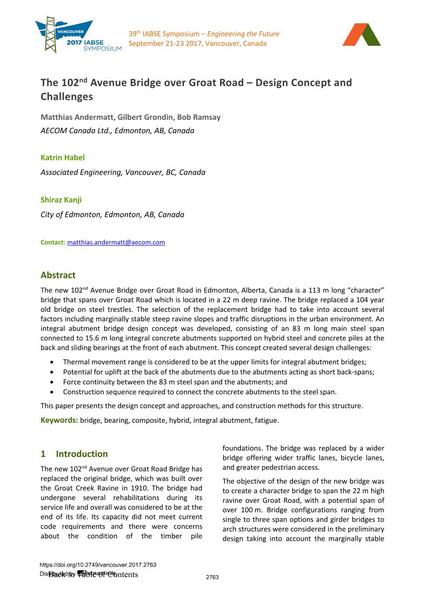The 102nd Avenue Bridge over Groat Road – Design Concept and Challenges

|
|
|||||||||||
Bibliographic Details
| Author(s): |
Matthias Andermatt
(AECOM Canada Ltd., Edmonton, AB, Canada)
Gilbert Grondin (AECOM Canada Ltd., Edmonton, AB, Canada) Bob Ramsay (AECOM Canada Ltd., Edmonton, AB, Canada) Katrin Habel (Associated Engineering, Vancouver, BC, Canada) Shiraz Kanji (City of Edmonton, Edmonton, AB, Canada) |
||||
|---|---|---|---|---|---|
| Medium: | conference paper | ||||
| Language(s): | English | ||||
| Conference: | IABSE Symposium: Engineering the Future, Vancouver, Canada, 21-23 September 2017 | ||||
| Published in: | IABSE Symposium Vancouver 2017 | ||||
|
|||||
| Page(s): | 2763-2770 | ||||
| Total no. of pages: | 8 | ||||
| Year: | 2017 | ||||
| DOI: | 10.2749/vancouver.2017.2763 | ||||
| Abstract: |
The new 102nd Avenue Bridge over Groat Road in Edmonton, Alberta, Canada is a 113 m long “character” bridge that spans over Groat Road which is located in a 22 m deep ravine. The bridge replaced a 104 year old bridge on steel trestles. The selection of the replacement bridge had to take into account several factors including marginally stable steep ravine slopes and traffic disruptions in the urban environment. An integral abutment bridge design concept was developed, consisting of an 83 m long main steel span connected to 15.6 m long integral concrete abutments supported on hybrid steel and concrete piles at the back and sliding bearings at the front of each abutment. This concept created several design challenges:
This paper presents the design concept and approaches, and construction methods for this structure. |
||||
| Keywords: |
bridge fatigue composite bearing integral abutment hybrid
|
||||
